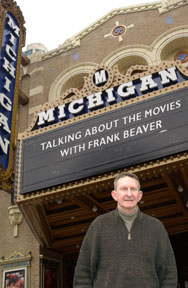October 2005
Talking about the movies: Rudolf Arnheim’s Film As Art
with Frank Beaver
This is the second entry in a three-part series on classic media-theory, focused on books I recommend as essential reading for students of the motion picture.
Last month I discussed Susan Sontag’s provocative ideas on the cultural, aesthetic and ethical implications of still photography, a precursor to "motion" photography but an art medium that, for Sontag, holds distinctive appeals quite separate from those of cinematic art. Among many salient observations in her book On Photography (1977) is the notion that while photographs are mechanically derived images of "real people" and a "real world," they are nonetheless objects of art.
Decades, earlier, Rudolf Arnheim applied the same aesthetic assumption to motion pictures in essays he wrote in Germany and Italy in the 1930s, and then, in 1957, reworked and published in the United States as Film as Art by the University of California Press.
In his foreword to Film as Art, Arnheim says that "it was the precarious encounter of reality and art that teased me into action. I undertook to show in detail how the very properties that make photography and film fall short of perfect reproduction can act as the necessary molds of an artistic medium."
Even though the reworked edition was published 20-plus years after the originals, Arnheim chose to limit his discussions primarily to films produced during the medium’s silent-film era—a time when Arnheim noted that cinema was evolving as "a unique experiment in the visual arts." The works cited in his essays draw heavily on the silent films of Charlie Chaplin, F.W. Murnau, E. A. Dupont, Carl Dreyer, Rene Clair, Serge Eisenstein, King Vidor and other early innovative directors who pointed the direction toward film as art.
Arnheim based his argument for photographs and films’ being something more than mechanical reproductions on an analysis of those peculiarities within the photographic process that move the two mediums away from being mere records of "reality." He began by noting that both media produce images in two-dimensional formats and rendered (within Arnheim’s critical universe at the time) in black-and-white.
Next he discussed the wide variety of aesthetic choices, each of which alters the image: camera-angle and camera placement onto the scene or object, the selection of the camera lens with its penchant for spatial distortions, lighting arrangements that affect our perception of objects within the photographed image and, especially significant for film, the interruption of the time-space continuum through editing.
Arnheim’s interest in and understanding of the interrelationship between art and visual perception—a field of inquiry in which he would become a leading scholar—is very much evident in Film as Art. For example, a distinguishing factor between "reality" and film art, he says, is the "relativity of movement in film," such as the use of a rapidly moving camera that will allow the spectator (in a static position) to participate in a unique, giddiness-producing visual experience that is not possible for the human eye alone. Arnheim maintains that film visualizations can stimulate all sorts of sensory sensations and hence, he argues, a film above all else must be "visual" in the expression of its content.
Having laid out the resources available to film, Arnheim moves into a lively, well-articulated set of analyses that illustrate how the medium’s peculiarities have been used for artistic effect. He cites memorable scenic moments in classic silent film, always emphasizing the way diverse screen visualizations affect the spectator: the clever placement of camera at the beginning of Chaplin’s The Immigrants, the use of unusual angles in filming the characters in Dupont’s Vaudeville (first titled Varieté), Dreyer’s close camera placement to effect dynamic perspective changes in The Passion of Joan of Arc, light and dark visual contrasting in Josef von Sternberg’s The Docks of New York, the use of montage in the editing of Eisenstein and Vsevolod Pudovkin to "build" their films and drive home their revolutionary ideas.
Arnheim also puts due attention to film acting and to the ways that film can express abstract and complex ideas not just through captivating camera visualization but through dramatic invention within the narrative as well. Chaplin’s brilliant pantomimic correlatives in The Gold Rush are cited, for example, the well-mannered eating of a boot, devised as a pointed commentary on the contrast between rich and poor.
Film as Art concludes with two short essays, both written in the 1930s, that speculate on the artistic possibilities of talking pictures and of television, a further indication of the book’s prescient brilliance.
Rudolf Arnheim lives in Ann Arbor which he chose as his home in retirement. On July 15 of this year he celebrated his 101st birthday.

Film historian and critic Frank Beaver is professor of film and video studies and professor of communication.
|


